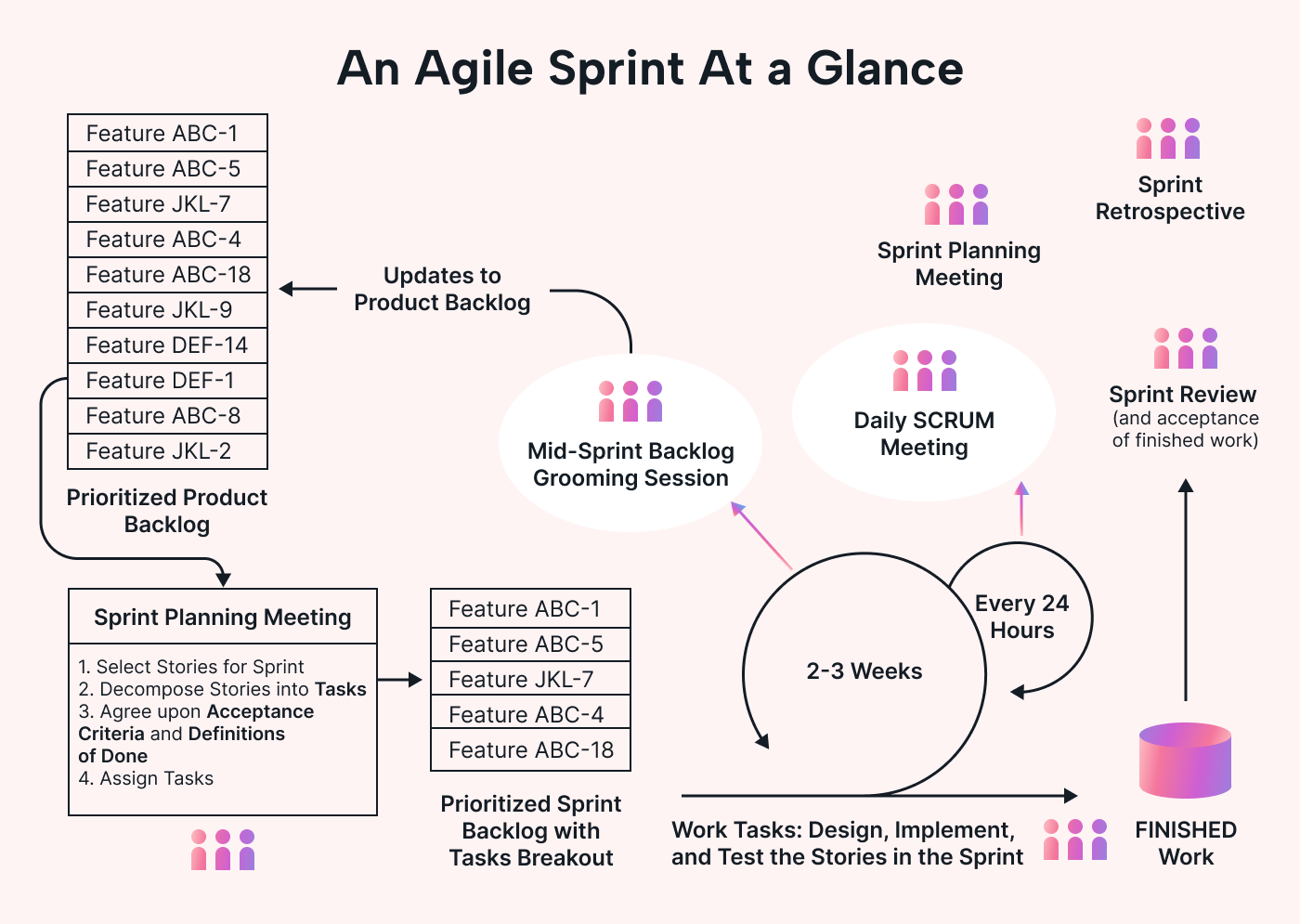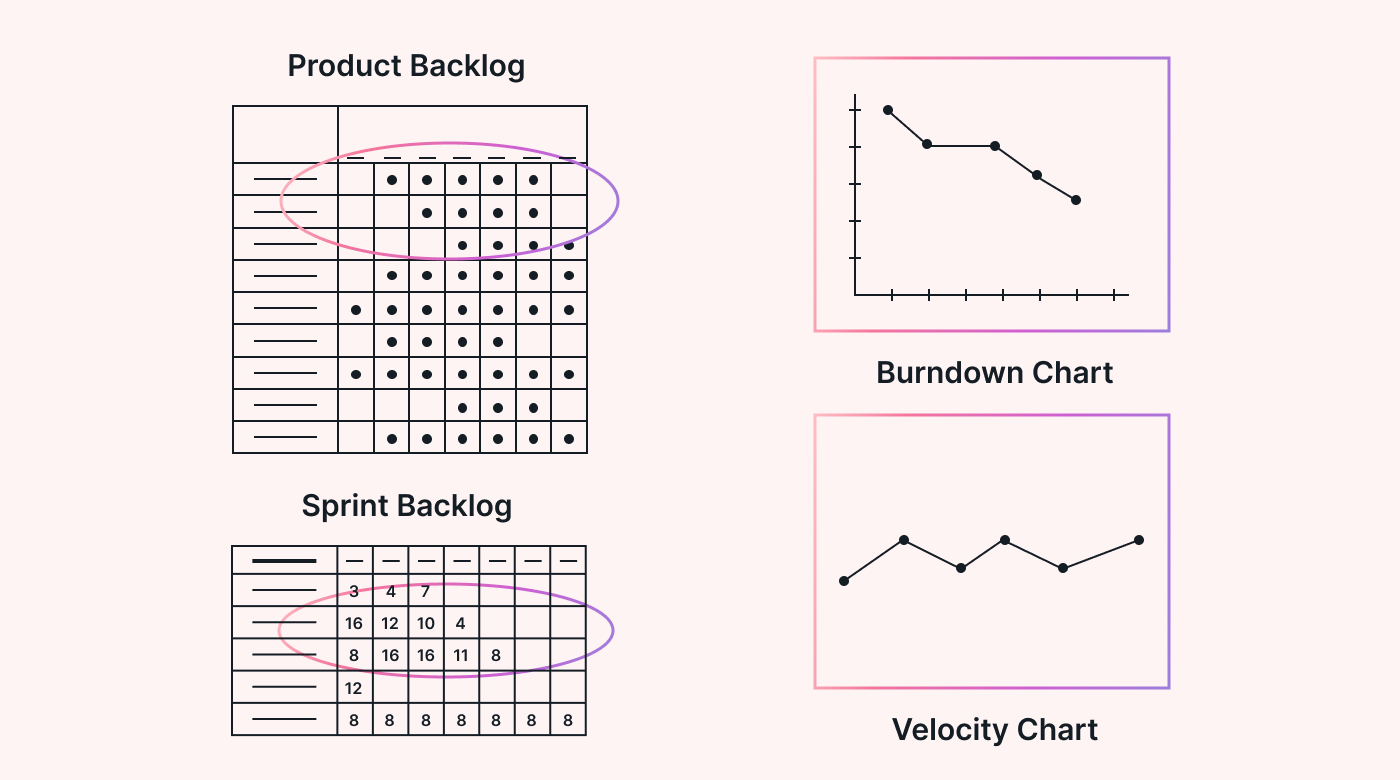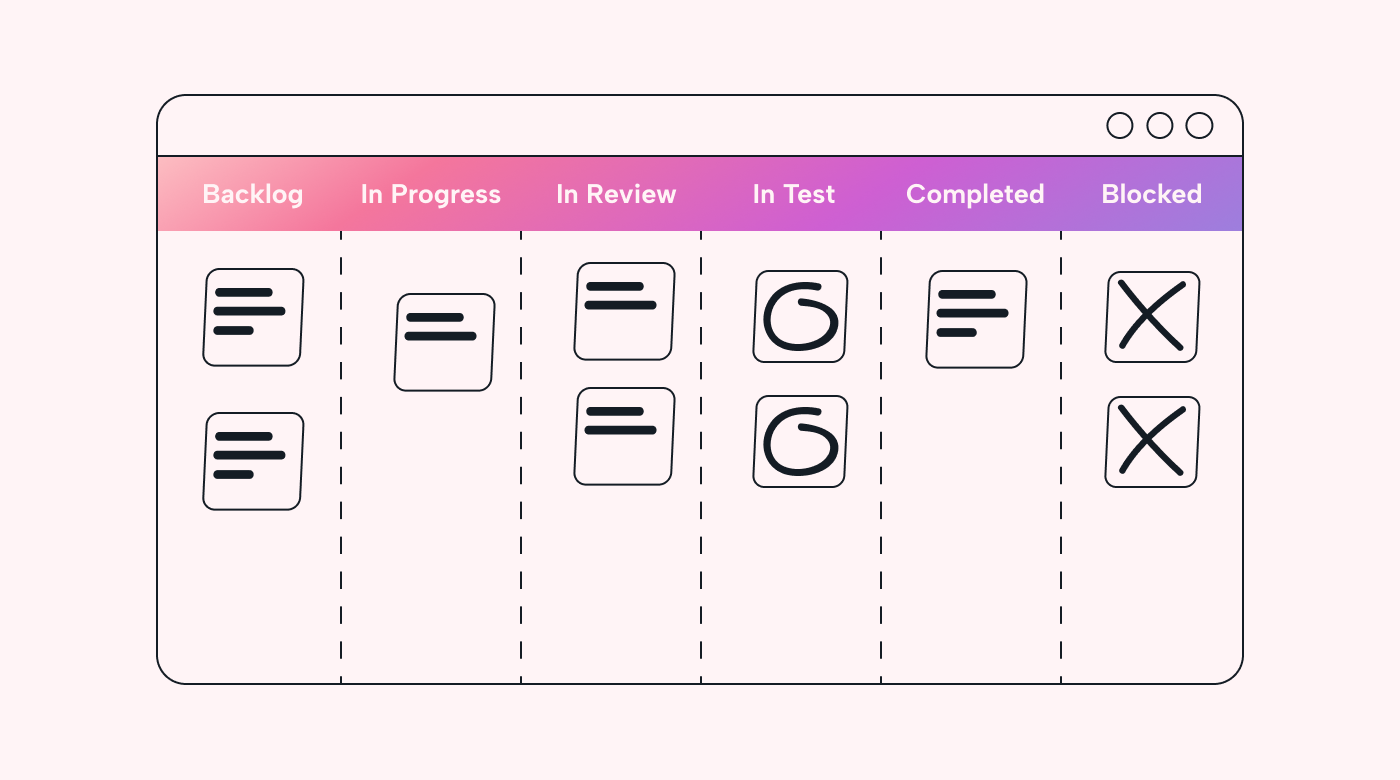The most basic element of any Agile project management process is a sprint. And while there are numerous detailed definitions of that term, all agree that an effective sprint is short (weeks, not months), well-planned, and has a single predetermined outcome or deliverable.
Sprints originated in software development, where an end product comes from multiple short iterations. And while the idea has now gained traction in other sectors and businesses, most of the terminology hasn’t changed.
For example, almost every guide to sprint planning speaks of a product backlog. If you’re not building a new whizz-bang app to change the world, you should probably view this simply as the list of things or tasks still to be completed. And that’s where every sprint plan begins.
The heartbeat of Scrum
The idea behind sprints
To understand how sprints came to be, we need to take a step back and look at the Scrum framework, a popular Agile methodology. Simply put, this is a structure that guides the development and maintenance of complex products.
Scrum is also the most popular of the new class of Agile project management frameworks. This high adoption rate is due to its effectiveness: teams using this framework have 250% better quality outcomes [PDF] than teams that don’t.
Many of these teams have seen a dramatic improvement in their productivity, some by as much as 800%. And it is this uptick in productivity that drives the improvements in quality.
The main reason for choosing Scrum lies in one of the key advantages of the methodology: teams can work simultaneously rather than sequentially.
Scrum master vs project manager
Agile methodologies have mostly been used in software development and IT. However, companies are now exploring their use in other environments, so let’s take a look at the differences between Scrum and more traditional project management techniques.
The short version is that Scrum masters focus on ensuring the team, including the product owner, follows the Scrum framework principles. Meanwhile, project managers are responsible for the whole project, including logistics, budget, and risks.
Lately, operations, marketing, security, HR, sales, finance, and hardware development teams have opened their arms to embrace Agile methodologies in general and Scrum in particular.
Strength in Scrums
Scrum is really just a sequence of carefully coordinated sprints, and the clearly defined nature of each sprint is one of its biggest strengths. But Scrums are also flexible and able to adapt to changing circumstances.
 |
They also result in stable products and have robust feedback loops that usually result in on-time delivery. Scrums also encourage team cohesiveness and growth. They can reduce the risks normally associated with projects and deliver a better return on investment.
Planning a successful sprint
Defining the sprint
One of the characteristics of Scrum is the sprint — a short period during which a team works to achieve a clearly stated and pre-defined objective. But the secret sauce for a successful sprint is the planning. Motion can assist with automating and streamlining sprint planning and other Scrum ceremonies.
A sprint always begins with user stories, often submitted by the product owner for review. The purpose of sprint planning is to decide what user stories to tackle in the upcoming sprint and reach an understanding of the sprint goal.
The sprint planning session involves the product owner, team, and the Scrum master. The team figures out exactly what work is required to achieve the sprint goal.
The power of sprints
Sprints are what underpin the Scrum framework. They allow you to set a single objective and a fixed (and short) time in which to realize it. This commitment to outcomes and finite deadlines is what makes the methodology so powerful.
The guiding principle of Scrum is that work must be iterative, meaning large projects are broken down into small, manageable chunks. Each chunk is then dealt with in a sprint lasting weeks, not months.
Sprints allow each team to focus on a single task and to complete it before moving to the next one. You can also run several sprints in parallel, so embracing tools supporting the Scrum framework, such as Motion, is critical.
Why sprints are always short
Experience has taught that sprints of a shorter length make planning much easier. The shorter the sprint, the more likely you are to achieve the sprint objective because there is no time to get lost in insignificant details.
 |
There are other benefits to short sprints. For example, they can help make the development process low or even risk-free. This is due to the inherent feedback loop: the faster crucial feedback comes in, the quicker you can include it in the next step.
Artifacts of sprint planning
Another vital benefit of sprints is simplicity. There are two important artifacts that come out of sprint planning: a sprint goal and a sprint backlog.
The first is best defined as the single objective for that particular sprint. Its purpose is to focus the team’s attention on what the sprint must achieve and to keep it focused on achieving that objective.
The second artifact is a list of tasks to be completed during the sprint. In the planning meeting, the team selects from the product backlog items. The list of tasks needed for each item is determined, along with estimates of how long each task will take.
The simplest way to accomplish this is to use a dedicated software tool, preferably web-based for easy access. Motion has such a tool that allows you to to create and manage your sprint backlog, and collaborate with your team.
Best practices for sprint planning
Attributes of successful sprints
The three key attributes of a sprint planning are: design, velocity, and work allocation. In other words, the work required in the sprint, the capacity for doing the work, and who will complete which specific tasks. If the sprint planning meeting is used to clearly define all of this, success is far easier to attain.
The official Scrum guide also suggests three core topics to address during sprint planning. Phrased as questions, they provide a useful way to lay out the work needed for the sprint to achieve its single objective:
- Why is this sprint valuable?
- What can be done this sprint?
- How will the chosen work get done?
Derek Huether has compiled a very useful sprint planning cheat sheet for those who are a little more detail-oriented. It provides a good template to put you on the right track in planning your first sprint.
The sprint planning checklist
Other approaches to sprint planning involve templates such as the checklists published by Scrum.org.
Checklists can be useful to both junior practitioners and experienced project managers or Scrum masters. In the first case, it helps by guiding the process of what to do, and in the second, it helps to deal with the many complexities involved.
It’s helpful to think of checklists, guides, and templates as working documents that should be revisited and adjusted regularly according to the needs of your particular organization—but not during an active sprint.
When the sprint kicks off
Once the planning is complete, the sprint begins, and the product owner is expected to step back to let the team do its work. From this point until the last day of the sprint, the team will attend daily scrums (stand-up meetings) to discuss progress and brainstorm solutions to challenges.
To avoid scope creep, a common pitfall in project management, the product owner participates in these daily meetings as an observer who can answer questions and control change requests.
Tips for better sprint planning
Many things could easily derail the sprint planning process and the next sprint. But some of the most common pitfalls to be aware of include:
- Not limiting the sprint planning meeting to an hour (or two) for every week of the sprint.
- Not clearly understanding how long each task should take.
- Overloading individual team members by allocating too many tasks.
- Not setting a clearly defined sprint goal so the team fully understands the objective.
- Not preparing or grooming the product backlog before sprint planning begins.
- Failing to clearly define what completed means, causing unnecessary delays.
Optimize your sprints with automation
When you have mastered the processes involved in sprint planning and the sprints themselves, it is time to streamline things with automation. Motion can also help you here by enabling you to automate repetitive tasks like reports and emails.
 |
The primary benefit is that your team can focus on the more important work and reduce the time it spends on mundane administrative tasks. This is where your choice of tools can help or hurt you.
Where the rubber meets the road
Many projects have successfully used Scrum, including helping an Argentinian health insurer embrace digital transformation, aiding in US cancer research, and improving customer experiences in retail.
But one case study stands out: A Case Study on the Impact of Scrum on Overtime and Customer Satisfaction [PDF] by Chris Mann and Frank Maurer. While its 10 pages cover the methodology as a whole, there are many lessons for sprint planning.
For example, it turns out that extending sprint lengths to accommodate extra work didn't help. Instead, trimming future sprints worked better.
The case study also quotes two customers on the subject of sprint planning:
- “Superb forum for planning; the whole team is involved and thus everyone knows what is required from them.”
- “Although the day as a whole can be a very tiring process, I have found that the time spent in the planning meetings has led to less misdirected development and a more clear understanding of both the requirements and the limitations of the development process by both the customers and the developers.”
This is a common refrain across many case studies.
Why sprint planning is critical
There’s an adage used in carpentry: measure twice, cut once. The reason is to avoid costly mistakes. The same is true of sprint planning. By devoting adequate time to the planning stage, you give your sprint the best chance of success.
Depending on the industry or discipline for which the sprint is planned, the rule of thumb is either one or two hours per week of the scheduled sprint up to a maximum of one full day. But perhaps the most important takeaway is that your sprint planning also needs a plan.
Try Motion’s Intelligent Calendar to make your sprint planning process easier with customizable dashboards that allow you to monitor project progress and key metrics at a glance. Motion also provides powerful reporting capabilities, including reports on sprint progress, burndown charts, and other key metrics.





